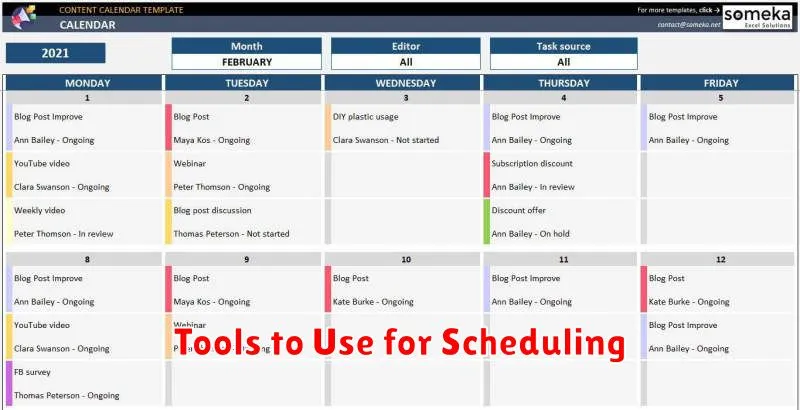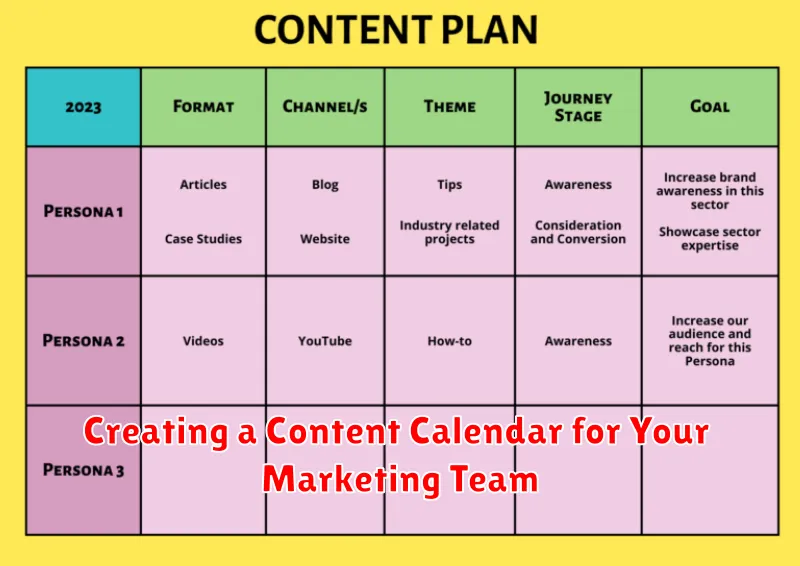In today’s fast-paced digital landscape, a content calendar is an indispensable tool for any successful marketing team. A well-structured content calendar provides a strategic roadmap, ensuring consistent, high-quality content creation and distribution across various platforms. This organized approach helps to streamline workflows, maximize resource allocation, and ultimately achieve marketing objectives. Whether your goal is to boost brand awareness, drive website traffic, generate leads, or nurture customer relationships, a content calendar serves as a central hub for all your content marketing initiatives, fostering collaboration and optimizing your content marketing strategy.
This article will delve into the crucial elements of creating a highly effective content calendar specifically tailored for your marketing team. We will explore the key components to include, discuss various content calendar formats and templates, and provide practical tips for successful implementation and ongoing management. From brainstorming content ideas to scheduling publication dates and assigning responsibilities, you will gain a comprehensive understanding of how a content calendar can transform your content marketing efforts and drive measurable results. By the end of this article, you’ll be equipped to create a content calendar that empowers your team to produce engaging and impactful content consistently.
What Is a Content Calendar?
A content calendar is a strategic tool used to plan and schedule your marketing content. It provides a centralized view of all your upcoming content pieces, across various platforms and formats. Think of it as a roadmap for your content marketing efforts.
It typically includes key information like the content topic, publishing date, target audience, platform (e.g., social media, blog, email), content format (e.g., video, article, infographic), and the team member responsible.
By using a content calendar, you can ensure consistent posting, avoid last-minute scrambles, and maintain a cohesive brand message across all channels.
Benefits of Organized Planning
Organized planning, particularly with a content calendar, offers numerous advantages for marketing teams. Efficiency is a key benefit, as it streamlines content creation and distribution. By outlining topics and deadlines in advance, teams can avoid last-minute rushes and allocate resources effectively.
Consistency is another crucial advantage. A content calendar ensures regular output, which helps maintain audience engagement and brand visibility. This predictable cadence allows for better strategic alignment with overall marketing goals.
Finally, organized planning fosters collaboration. A shared calendar provides transparency and facilitates communication among team members, enabling everyone to stay informed and contribute effectively.
Tools to Use for Scheduling

Several tools can streamline the scheduling process for your content calendar. Selecting the right tool depends on your team’s size, budget, and specific needs. Free options like Google Sheets or Trello provide basic calendar functionality, ideal for smaller teams or those just starting out. These tools allow for collaborative editing and task assignment.
For more robust features, consider dedicated social media management platforms. Tools like Hootsuite, Buffer, or SproutSocial offer advanced scheduling capabilities, analytics tracking, and engagement monitoring. These platforms are often a good choice for larger teams or businesses managing multiple social media accounts.
Finally, marketing automation platforms like HubSpot or Marketo provide comprehensive content calendar management, integrating scheduling with email marketing, lead nurturing, and other marketing activities. These are suitable for large organizations with complex marketing strategies.
Assigning Roles and Responsibilities
A successful content calendar requires clearly defined roles and responsibilities. This ensures accountability and streamlines the content creation process. Assign ownership for each stage of the content lifecycle.
Consider these key roles:
- Content Strategist: Oversees the overall content strategy and calendar.
- Content Creator: Produces the actual content (blog posts, articles, social media updates, etc.).
- Editor: Reviews and refines content for quality, accuracy, and consistency.
- Social Media Manager: Schedules and distributes content across various social media platforms.
- SEO Specialist: Optimizes content for search engines.
Depending on your team size, one person may handle multiple roles. Clearly documented responsibilities are essential, regardless of team size.
Reviewing and Updating Your Plan
A content calendar isn’t a static document. It requires regular review and updates to remain effective. Consistent monitoring ensures your content remains relevant and aligned with your marketing goals.
Schedule regular reviews, perhaps weekly or monthly, to assess performance. Analyze metrics such as engagement, reach, and conversions. Identify what’s working and what isn’t.
Based on your analysis, adjust your plan. This could involve tweaking content topics, shifting publication dates, or reallocating resources. Be prepared to adapt to changing trends and new opportunities.

